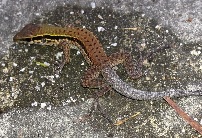|
Giant Ameiva (Ameiva ameiva)
Classification: Introduced Species. This species has been introduced into the United States with thriving populations in South Florida.
Description: Ameiva ameiva has a streamlined body, pointed head, slightly forked tongue, and muscular hind legs. They grow to approximately 18–20 inches. Both sexes have random black specks and mottling along the sides. Females usually have much less green than males and a more dusty of a green color. Males have vibrant green coloration and more bold mottling. Males also have more expanded jowls. They are popular as a pet because of the male's striking green coloration.
Habitat: Giant ameivas are found in varied habitats, such as cerrado and northeastern caatinga in Brazil and Amazonian savannah and forests. They seem to prefer disturbed rain forests that have recently been harvested
Range: Introduced in Florida. It is widespread in Central and South America, including: Panama, Brazil, Colombia, Surinam, French Guiana, Guyana, Venezuela, Bolivia, Ecuador, Peru, Argentina, and Paraguay. It is also found on the Caribbean islands of Trinidad and Tobago, Grenada, the Grenadines, Barbados, Margarita, Swan Island, and Isla de la Providencia. It was also once present on Saint Vincent but has since been extirpated.
Found in these States:
FL
Diet: Its diet consists of mainly insects (such as grasshoppers, butterflies, cockroaches, beetles, termites, and insect larvae), frogs, other lizards (such as anoles), and spiders.
Reproduction: The female lays several clutches of eggs from March to December. The reproductive habits of Ameiva ameiva are based on rainfall. In areas where rainfall is constant or unpredictable throughout the year, reproduction is year-round. In areas where there is a distinct dry season, reproduction only occurs during the rainy seasons.
Status: Listed as Least Concern on the basis that this is a common and very widespread species that thrives in modified environments. In the Grenadine archipelago, populations currently attributed to Ameiva ameiva very probably represent a separate species, and this is a source of some specific conservation concern since the population is fragmentary and at risk from introduced mammalian predators, specifically mongoose. It is not thought to be at immediate risk of extinction on these islands as it persists in anthropogenic areas from which mongoose are largely excluded, but efforts are needed to ensure that the invasive species does not become established on islands of the archipelago which are currently mongoose-free
»» Kingdom: Animalia - Animals
»» Phylum: Chordata - Chordates
»» Subphylum: Vertebrata - Vertebrates
»» Class: Reptilia - Reptiles
»» Order: Squamata - Lizards
»» Family: Teiidae - Whiptails & Racerunner Lizards
»» Genus: Ameiva
»» Species: Ameiva ameiva - Giant Ameiva
»» Subspecies: None
This article uses material from the Wikipedia article "Ameiva ameiva", which is released under the Creative Commons Attribution-Share-Alike License 3.0. Content may have been omitted from the original, but no content has been changed or extended.
|
|








